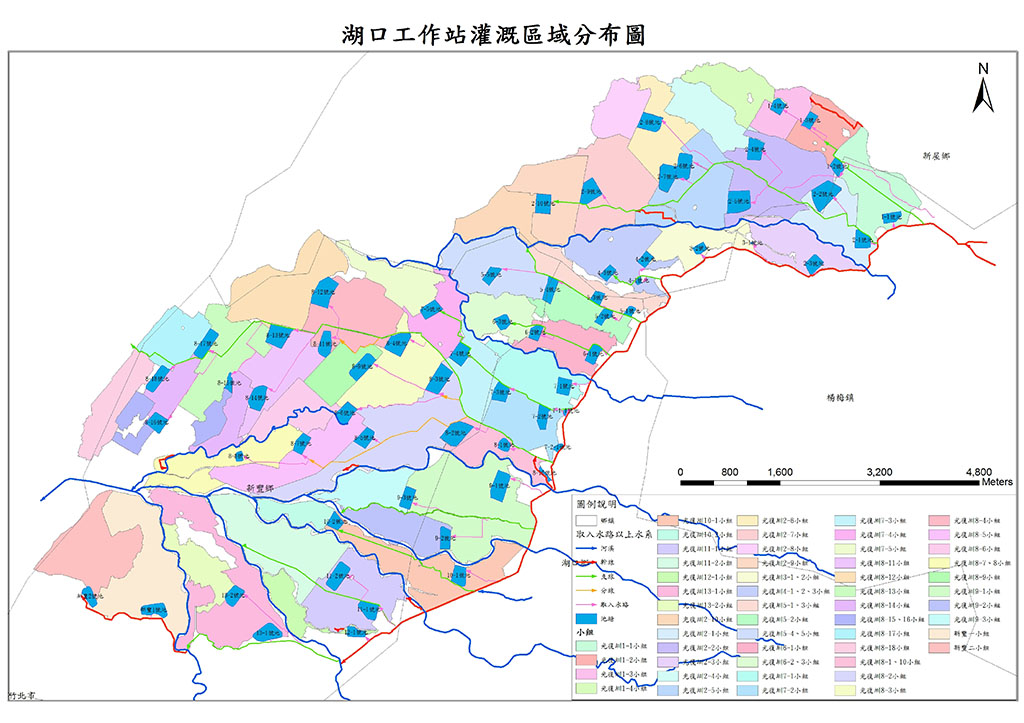The Hukou Irrigation Area is a plateau with very few water sources. To meet the needs of farmland irrigation, the early settlers explored irrigation water sources and built channels to facilitate the management of irrigation facilities and allocation of irrigation water. "Sanqi Canal" office for public canals was set up during the period of Japanese rule.
1. Establishment date:
During the period of Japanese rule, Sanqi Canal (now Lateral Canal 1 of Guangfu Canal) dug by settlers during the Qing Dynasty was named Sanqi Canal office for Public Canals, and established in Xinwu Township.
1924, Re-designated Sanqi Canal Irrigation Cooperative.
1940, Is merged with private canals in the region to form Hukou Irrigation Cooperative with an office in Hukou Township, as part of an irrigation merging program.
October 1946, Reorganized by provincial order and named "Hukou Irrigation Water Conservancy Association."
February 1, 1948, Renamed "Hukou Irrigation Committee."
May 1952, Renamed "Hukou Irrigation Coordination Committee" by provincial order.
August 1956, Reorganized into the Hukou Water Resource Management Office under the Provincial Water Resource Bureau.
October 15, 1956, Approved to merge into the "Taiwan Taoyuan Irrigation Association," establishing Hukou Workstation with three sub-workstations; Fengye, Xinfeng and Dapo.
2. Location and relocation: During the "Sanqi Canal" period during Japanese rule, an office was established in Xinwu Township. In 1940, the irrigation area was expanded and it was re-designated "Hukou Irrigation Cooperative" with a Japanese-style wooden office building set up on Zhongzheng Road, Hukou Township. On September 9, 1969, it relocated to No. 2, Lane 127, Dexing Road, Desheng Village, Hukou Township (the current site) as a two-story reinforced concrete building. The area is 3,220 hectares (the land is owned by the association, the land plot number 420-2, Desheng Section, Hukou Township).
(1) In August 1954, when Fugang Monitoring Station was under Hukou Irrigation Management Office, it established the Fugang Monitoring Site, with an office rented on Zhongzheng Road in Fugang Village. In 1956, it was renamed Fengye Sub-workstation after the merger with Taoyuan Irrigation Association. In 1975, the Association bought land and constructed a two-story reinforced concrete building at No. 223, Minsheng Street, Fengye Village.
(2) In August 1954, when the Xinfeng Sub-workstation was under Hukou Irrigation Management Office, it established Zhonglun Monitoring Site, with an office rented from Mr. Xu Yuanqi at No. 1, Neighborhood 2, Chongxing Village, Xinfeng Township. In 1956, it was renamed the Xinfeng Sub-workstation after the merger with Taoyuan Irrigation Association. In 1976, the Association bought land and constructed a two-story reinforced concrete building at No. 25, Xinzhuang Road Xinfeng Township. It was ended in 1995 as irrigation management was no longer needed.
In 1956, Dapo Sub-workstation was established and rented a house as its office in Dapo Village when it merged with the Taoyuan Irrigation Association. In 1967, it was merged into the Xinwu Workstation.
When it was first built more than 100 years ago, the water source of Sanqi Canal was diverted from the tail section of Yangmei River. It was fed through Shezi River to irrigate farmland in Yinyingwo, Yuanben in Yingmei Township and Shezi, Lang, Benzigang and other areas of Xinwu Township. At the time, the irrigated area was about 300 hectares in size. In 1939, in order to increase rice production, Hsinchu Prefecture merged 2,083 hectares of farmland in Xinwu Township and 889 hectares in Yangmei Township, totaling 2,792 hectares, into the "jurisdiction of Sanqi Canal Irrigation Cooperative." In 1940, irrigation mergers were implemented and it was renamed Hukou Irrigation Cooperative. In September of the same year, Heke Canal in Xinwu Township and Caonanbo Canal in Yangmei were built, and the irrigation area was increased to 3,360 hectares. According to irrigation merging principles at the time, due to the urgent need for grain, 7,300 hectares of private canals were also incorporated into parts of Yangmei Township, parts of Hukou Township, and parts (now Songlin Village, Xinfeng Township) of Xinfeng (originally named Hongmaozhuang) and Jiugang townships (now Zhubei City) in Xinwu Township to expand the jurisdiction. At that time, the total irrigated area reached 10,664 hectares. However, due to the lack of fixed water sources, it was difficult to increase agricultural production. In 1956, when it was merged with Taoyuan Irrigation Cooperative, the irrigated area of Hukou Workstation was 5,627 hectares. In 1967, it was readjusted to an irrigated area of 5,205 hectares. In the same year, after Dapo sub-workstation was merged into Xinwu Workstation, the irrigation area was just 3,990 hectares left. As a result of farmland readjustment and urban development over years, the irrigation area has since fallen to the current level of 3,802 hectares.
